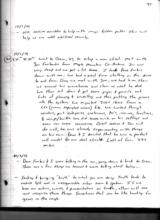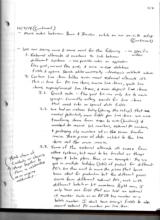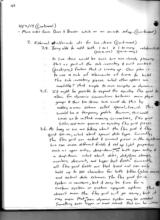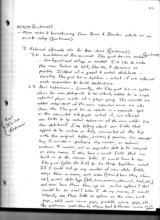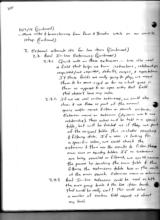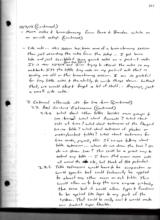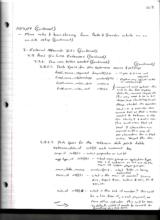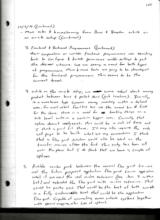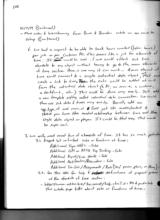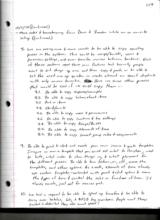|
Basic Assignments
|
Options & Settings
|
Main Time Information
|
||||||||||||||||||||||
|
|
|
|
|
|||||||||||||||
|
Photo/Image Count: 13
|
|||||||||||||||
|
|||||||||||||||
|
|
|
Notes:
|
|
Myself and an associate were talking in the car, going down and back to Orem. These are a few things we learned and were talking about today: -Seeking and bringing “truth” to what you are doing. Truth tends to radiate light and is recognizable when seen and spoken. If we base our actions, words, and presentations on truth, others will see and recognize those things. Sometimes that can be like hunting for gems in the rough. -Compound concepts – This was a topic that he was talking about. I loved the idea of compound or multiple concepts working together. The reason he was talking about “compound” was certain concepts have inter-relationships between pieces. If you take them apart, they fail or don't work. However, if you use them in combination, they flourish, prosper, and grow. We talked about tons of things both spiritual, gospel, and business. Lots of fun things here. -Be considerate of other people's time. In a way, how you treat their time or interact with people has some underlying tones about your love or care for that person. Granted, that may not be a perfect model, but it was fun to think about time as a gift. Then how we respect that gift of time and how that can relate back to love. This was a fun compound concept – time and love. -Just for fun, here were a couple other topics we had fun with... Compound Concepts – The God Head (The Father, the Son, and the Holy Ghost), Faith, hope, and charity; revelations, obedience, and intelligence; Tasks, goals, and dreams (the big picture), relationships, between things (objects and data) over time – how does time play into relationships? We also talked tons about inter-dependencies inside of the business world, systems, adilas, etc. Fun topics! The key was going back to the idea of a compound concept.... by itself, it needed something else. Together or in combination, it grew, thrived, and flourished. Pretty cool! -Different Business models: Separated Model vs Systemized Model We are seeing more and more need for the following – notes from an on-site setup – no specific order: 1. External alternate id numbers to link between different systems – see possible notes on application flex grid, normal flex grid, and more in-line database fields and options. Search adilas university – developer's notebook entries. 2. Certain line item tables even need external alternate id's. This is true for PO line items, invoice line items, quote line items, expense/receipt line items, and even deposit line items. [External alternate id's for line items] 2.1. Quick note – flex grid tie-ins only tie to main groups. Currently nothing exists for line items that need subs or special data fields. 2.2. We had an instance today (during the setup) that we needed potentially more fields per line items. We were transferring items from area to area (locations) and needed to record lot numbers, external PO numbers, and packaging slip numbers all on the same transfer invoice. These pieces of data related to the line items not the main invoice. 2.3. Some of the external alternate id's come from other systems, but need to be tracked as things happen and take place. Here is an example: Say we got in multiple batches (lots) of product for different PO's. We then want to move the pieces that have been okayed for production but the different pieces come from different external PO's, each with different batch or lot numbers. Right now, I only have one field that can hold an external id number such as an RFID tag number or a batch number. I don't have enough fields to also record external PO numbers per line item. (Think chain of custody or chaining things together to show a relationship or an ongoing relationship...) 2.4. Being able to add both one-to-one and one-to-many relationships to line items would be cool. We are already planning this as part of the sub inventory and cost controls (packaging) feature that is coming up. Our plan is to use a sub of elements of time to hold the sub inventory pieces. What other options are available? Think simple to more complex or dynamic. 2.5. It might be possible to expand the existing flex grid to allow for dynamic connections between main player groups and their line items. We could do this by adding a new column called special_line_id. This would be a temporary patch. However, this would cause us to rethink naming conventions, flex grid titles, and even queries on existing flex grid pieces. 2.6. As long as we are talking about the flex grid and flex grid tie-ins, what about special data types. Currently,the flex grid can extend and connect pieces in the system. We can name different fields and set up light properties such as open entry, drop-down menus, or both open entry and a drop-down. What about dates, date/time stamps, numbers, decimals, and bigger text fields? Currently, all flex grid fields are text based and can only hold up to 100 characters for both titles (alias names and actual data columns. The flex grid tie-in system is awesome, but it may be time for a custom system or custom upgrade option. This doesn't mean the flex grid will go away, but it may mean that a new dynamic system may be needed. Something even bigger or more robust that can be configured and setup as needed. I'd like to make the new feature as light, flexible, and dynamic as possible. Instead of a preset and coded database – existing flex grid tie-in system – what if we allowed each corporation to build extensions. 2.7. Real extensions – Currently, the flex grid tie-in system allows for new data points to be virtually added to a single individual player inside of a player group. The records are added independent of the main individual record. We also show the flex grid tie-in records in a separate spot on the associated sub pages. What if, we allowed new fields to be actual extensions of the main and/or line databases? I'm talking about new fields that appear to be in-line or fully connected at the hip with the original tables, entries, and queries. For example: Say I wanted a packaging slip number, an external customer PO number, and an expiration date to be assigned on every invoice. I only have a couple fields that are built-in to the invoices table. I would have to use flex grid (after the fact) to tie things together. What if I could set up any number of new data fields, assign them a name, sort order (where and how they show up), a real data type (date, time, numeric, decimal, text, etc.), and even have them show up as in-line options? That would be so cool! When I do my invoice, I would literally see those fields as options on the view cart page, edit main invoice page, printable invoice page, etc. The extensions could then be shown back to the user in-line or in-place. (Real In-line Extensions) 2.7.1. Quick note on these extensions.... we also need a field that helps us know instructions, relationships, required/not required, defaults, ranges, and expectations. If these fields are really going to play, we need them to be more rigid as far as what goes in them as opposed to an open entry text field that doesn't have any rules. 2.7.2. If we use real in-line extensions, we could also show and use them as part of the normal query and/or search filters or search criteria. Extension means an extension (dynamic one to one relationship). These values will be held in a special table, but will be treated as if they are part of the original table. This includes searching and filtering data. If a user is looking for a specific value, we could check the extensions and then use the results to filter the main core or existing tables. If no extensions are being searched or filtered, we could reverse the process by searching the main table and then filtering the extensions table base on the results of the main search. Extensions means an extension... 2.7.3. Real In-line extensions could be used on both the main group levels and the line item levels. That would be really cool! This could solve a number of custom field requests at almost any level. 2.7.4. What other tables besides main groups and line items? What about payments? What about subs of time? What about extensions of the flex grid tie-ins table? What about extensions of photos or media/content tables? What about extensions for time cards, payroll, etc. If we are talking about table extensions.... where do we draw the lines? Or do we draw lines? This could be a great way to extend any table... I know that means more code all around the site, but think of the potential. 2.7.5. Table extensions would have to be corporation or world specific but could technically be applied to almost any other main or sub table. This would allow us to keep the core engine virtually the same but it would allow types and functions to be applied like legos to any part of the system. That could be really cool and would make our product super flexible. 2.7.6. I see at least two new tables that are needed. They are the extension names and settings and the extension data points. The names and settings will hold all assignments, names, instructions, data types, defaults, rules, etc. The actual extension data point table will hold a number of pre-configured fields that just hold the data. In a nutshell, the actual extension data points table will be a plain white (vanilla) container. It will be general fields that can hold specific data. It will be the names and settings table that will help the general data points table know what to do. There may be some other supporting tables that go along with this, but these two main tables will be the core of the real in-line extensions. 2.7.6.1. Tech specs for the extension names and settings table: (General 1st round planning): please see scans in photo gallery for details 2.7.6.2. Tech specs for the extension data point table: please see the scans in photo gallery for details 3. Front-end and backend programmers – we are seeing a bigger need for tools for both front-end programmers (point and click interfaces and settings) and backend programmers (people who build the features and pages). The backend programmers are the hard core adilas developers that work in code all of the time. The front-end developers are the reps and consultants who help end users and companies to set up their corporations or worlds. Front-end programmers use existing tools to configure and tweak permissions and/or settings to get the desired outcome. We are seeing a need for both types of programmers. More and more tools are going to be developed for the front-end programmers. This seems to be the current trend. 4. While on the on-site setup, we were asked about moving product between bins and pallet docs (sub locations). Basically, in a warehouse type scenario moving inventory within a defined area. For most retail facilities we use the normal bin # field for the items. There is a need for tracking things on a sub level within a certain bigger area. Currently that option doesn't really exist. This could be a sub of time and I think a good fit there. It may also require the role call page to be built. What are my connections? I think that a flex grid solution could also be used on the transfer invoices after the fact. This entry has been all over the place but I do think that we have a couple of options. 5. Possible combo pack between the normal flex grid tie-ins and the future proposed application flex grid tie-in application. What if we used the real in-line extensions (see item 2 in this list) and extended the flex grid with in-line extensions. That could be pretty cool. That could be the best of both worlds in a fully customize-able level. That could be the application flex grid. Capable of connecting even outside systems together with special mapping, etc. Lots of options. 6. We had a request to be able to track hours worked (labor hours) per job or per Customer PO. This seems like a job for elements of time. It sure would be cool if we could attach sub time elements to any object without having to go to the main elements of time section. Here is one way it can work... A main element of time could connect to a single individual data object, and that could create a link to time. Then the subs could be added at will from the individual data object (a PO, an invoice, a customer, a stock/unit, etc.) This could be done very easily. Just add a new template setting called individual data connection. We could then use sub dates and time very easily. Basically, add an app_type_id and main_id field just like media/content and there you have the needed relationship between time and the single data object or player. It could be that easy. That would be super cool. 7. We really need round two of elements of time. It has so much potential. 7.1. Prepped but unfinished subs or functions of time: Additional Sign-Off's – Subs Additional GPS or RFID Tag Tracking – Subs Additional Payroll/Time Sheets – Subs Additional Notification/Reminders – Subs Additional Tie-In's/Assignments/Pools (“any” person, place, or thing) 7.2. See this URL for help and definitions of proposed pieces of the elements of time section: - https://data0.adilas.biz/top_secret/help.cfm?id=391&pwd=sub. This whole page talks about subs or functions of time 8. We are seeing more and more needs to be able to copy existing pieces in the system. This could be recipe/builds, users and permission settings, and even transfer invoices between locations. Each of these sections need their own features but basically people want to set things up once and then copy and paste or be able to see the next one up quicker or make almost an exact duplicate with only minor tweaks. Here are some other pieces that would be cool if we could copy them... 8.1. Be able to copy expense/receipts 8.2. Be able to copy balance sheet items 8.3. Part or items 8.4. Stock/units 8.5. Be able to copy users and permissions 8.6. Be able to copy locations and tax settings 8.7. Be able to copy Recipe/Builds 8.8. Be able to copy elements of time 8.9. Be able to copy smart group rules and assignments 9. Be able to point and click and create your own invoice and quote templates. Imagine an invoice template that you could set what to show/use, what to hide, what order to show things in, and what placement for the different pieces. Be able to turn features on, off, name the templates, and other options. As a note, elements of time already use custom templates – unlimited with point and click options to name the types of time and control the subs or functions of time. It already exists, just not for invoices yet. 10. We had a request to be able to speed up transfers and be able to carry over batches, lots, and RFID tag numbers. People want things tracked in detail but they also want speed. -Side note: This session has been more of a brainstorming session than just recording the notes from the setup... I got home late and just scribbled some quick notes on a post-it note. It is now 10/4/14 (two days later) and I'm trying to record the notes in my notebook. It's the little tiny note on my post-it note that is sending me off on this brainstorming session. I am so grateful for tiny little notes and the ability to write things down. Without that, we would skip and forget a lot of stuff. Anyway, just a small side note. |

